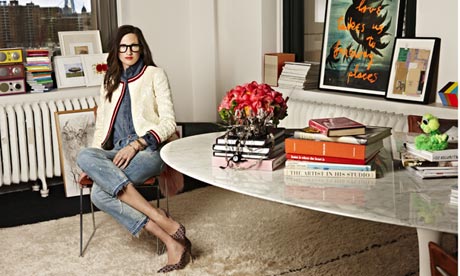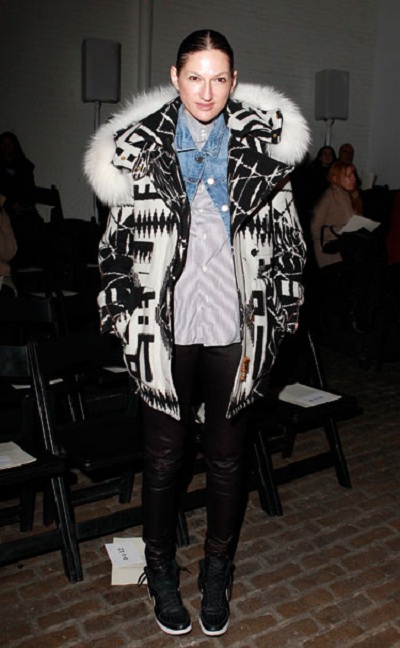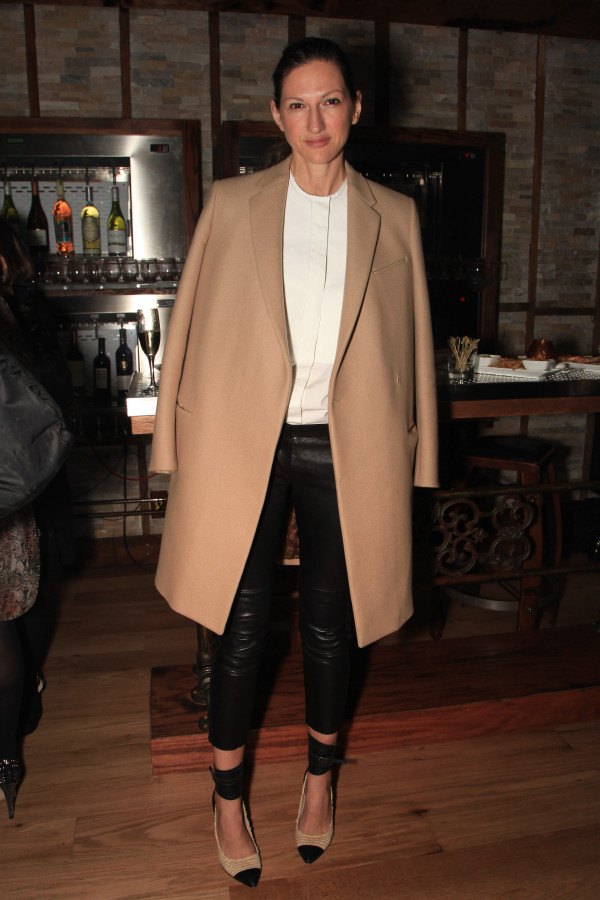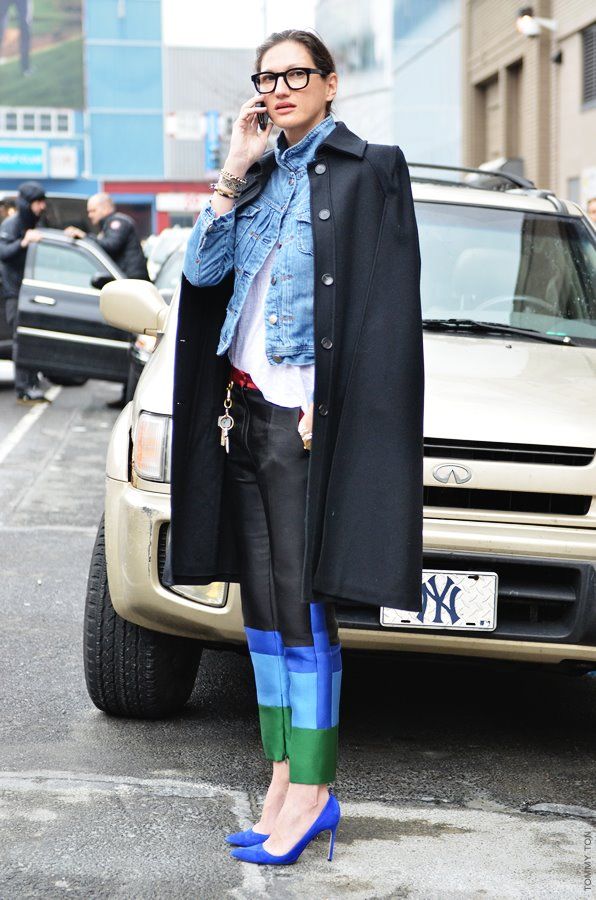














Jenna with a model styled in her image.....a classic clone of the star stylist.
“You have to make quick decisions,” Jenna Lyons, the president and creative director of J.Crew, told BoF. “Ultimately, fashion is all about gut anyway — there’s no science to what this should look like or that should look like or how many times you can redraw that or resketch that or redo that catalogue cover. The fact of the matter is, either it grabs you or it doesn’t.”
Indeed, it’s trust in instinct, perhaps more than anything else, that has enabled Lyons, in close partnership with fast-charging CEO Millard “Mickey” Drexler, to transform New York-based J.Crew from a stale catalogue company, once mentioned in the same breath as L.L. Bean and Lands’ End, into a creatively credible and highly desirable brand that’s stocked alongside Alexander McQueen at Net-a-Porter, counts numerous Vogue editors and Michelle Obama as loyal fans, and, on April 19, will launch hotly anticipated capsule collections designed by 2011 CFDA/Vogue Fashion Fund winner Joseph Altuzarra and runners-up Creatures of the Wind and Pamela Love.
The impact has been felt on the bottom line, as well. Revenue for J.Crew Group Inc. — which also includes Crewcuts for children, younger-leaning casual brand Madewell, and weekend-only online outlet J.Crew Factory — has more than doubled in the past eight years, while EBITDA, a measure of profit, has increased from $75 million in 2004 to $260 million in 2011, despite the challenging economic environment. J.Crew is also planning further international expansion, including a brick-and-mortar flagship in London’s Regent Street.
Successfully executing this impressive transformation has been a team effort, said Lyons, under whose creative direction the company has replaced the boxy acrylic cardigans and boiled wool clogs of yesteryear with sharp button-downs, fashionable cropped pants, and cute ballet flats in Italian leather.
“Ultimately, my job is really to make sure that everything that comes out of this company looks visually unified and looks good, looks like the brand, looks in my opinion beautiful,” she said. “But people think being a creative director [means] I’m actually touching everything and getting to create everything,” she continued. “In the end, honestly, what it’s about is taking care of all the creative people that work with you, really trying to make sure you’re nurturing them to the best of your ability and getting the best out of them. That’s the most important part of my role.”
So what does a day in the office look like for Jenna Lyons? “Never the same. Cramped. Crazy. Between the different things that I get to touch, whether it’s store design or store windows or the catalogue or the web or clothing design and Crewcuts and Madewell, I get to meet about a lot of different things,” she said. “I met with Mark this morning about locations for Fall catalogues; I met with Alice from Madewell about casting for Spring; we’re rigging the presentation for Holiday right now; I’m looking at marketing campaigns for Summer; and we’re talking about a brand book for international. There’s so many different things happening.”
Lyons grew up in Palos Verdes, California, and first moved to New York in 1987 to study at Parsons School of Design. After graduation, she worked briefly at Donna Karan, but left after a few months to join J.Crew, starting as a design assistant in men’s knitwear. “I realized I wasn’t touching anybody beyond the [fashion] world… and it felt really small,” she said. “Now I am fortunate because I have the opportunity to work in this company that touches a huge amount of people, but I also get to make things that are really beautiful.”
Striking a balance between creativity and commerciality has been a critical part of J.Crew’s success and something Lyons has managed to do extremely well. But that doesn’t mean it comes easily. “Honestly, it’s the thing that keeps me awake at night,” she said. “I swear if I had a formula for that, I would sell it,” she continued. But for Lyons, it comes down to instinct. “It’s just sort of looking at something and being like, ‘God, that looks too commercial,’ or ‘Wow, when you put all of those things together, it looks kind of boring.’”
In her more than 20 years at J.Crew, Lyons has worked in practically every single design department and faced some rough periods. After a private equity firm took a stake in J.Crew in 1997, the company cycled through four CEOs in five years. “I’ve had some hard times and some moments where I really wanted to leave,” Lyons admitted.
But the arrival of Mickey Drexler — known as the ‘Merchant Prince’ for his transformation of the Gap in the 1990s — was a turning point for the company. “When Mickey joined, it changed everything,” she said, describing Drexler as a veritable dynamo: “He has so many ideas and so much energy. He goes in ten million different directions. He’s funny and charming and serious and driven and excitable and supportive and intuitive and never sleeps…. I actually really love it. But it’s also chaos. He drives really hard. He will have input down to the button level on something and then he will have a 25,000 feet viewpoint on something else.”
“One of the first things that Mickey did when he got here was talked about quality, and one of the things we talked about was cashmere,” Lyons continued. “I was like, ‘Ugh, all the cashmere kinda sucks.’ And he was like, ‘Then change it.’” Today, fashion insiders rave about the J.Crew cashmere offering as one of the best available anywhere.
But far from an overnight revolution, driving change at a company the size of J.Crew was an evolutionary and iterative process. “It’s totally been organic. It’s been about trial and error,” said Lyons. “It’s not like we ever sat down and strategically said, ‘Okay, well, in the next couple of years this is what I’m hoping we can look like.’ I think it’s actually really hard to have those conversations when you’re talking about moving something that’s so big. I mean, this is a big company,” she said. “You can’t do anything quickly. You kind of have to go slow because you have a bunch of customers to get there with you. You can’t flip on them because that can get really confusing to people,” she added. “And so it’s really been a slow burn in terms of just trying something and then maybe tweaking it and saying, ‘Wow that really worked or this got a great response, this didn’t.’ And then trying something else.”
If Lyons has a philosophy of retail, it’s this: “make people feel special. Making people [realize] you’re paying attention to them is going to be increasingly important, because I don’t think people feel very special anymore.” It’s an insight she has brings to everything the company does. “Instead of the classic model, like, here’s a Gap store and here’s a thousand other Gap stores, we’ve really focused on trying to make sure each of our New York stores feel really special and jewel box. We want you to feel like there’s a reason to go into the store. You were in the downtown store, but that actually has slightly different product, has a different mood than the uptown store.”
And unlike many of its competitors, J.Crew isn’t afraid to take a real stylistic point of view, most famously with ‘Jenna’s Picks,’ a wildly successful section in the company’s catalogue and website — currently on hiatus — featuring products hand-picked by Lyons. “It was totally not my idea, just for the record. It was actually the person who ran marketing at the time, who’s no longer here, and wanted to do something that felt a little bit more personal. We were trying to make people feel like there was a selection of things.”
This kind of magazine-like curation has been an important part of J.Crew’s success. Indeed, the company even curates products from other brands —Belstaff jackets, Tretorn sneakers, Ray-Ban sunglasses, and Globe-Trotter luggage, for example — to sell alongside it’s own merchandise.
“Ultimately, I think what we’re trying to do is create something that feels a little bit more like a magazine and a little bit more like an inspirational piece — but that is also shopable.” To that end, the company’s catalogue has recently been rebranded as The J.Crew Style Guide. “So much more than a catalogue,” the company website states, “it’s your source for what to wear and how to wear it.”
Asked if she has any advice for aspiring fashion designers, Lyons replies: “Don’t be afraid to make a mistake. But do be afraid to not learn from them. In the end, it goes back to just wanting to change things and do a little better. It’s a constant process of always asking, ‘How can we be better? How can we be better? How can we be better?’”

No comments:
Post a Comment